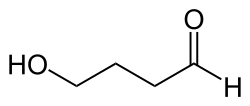4-Hydroxybutanal
4-Hydroxybutanal (γ-Hydroxybutyraldehyd) ist eine chemische Verbindung aus der Gruppe der Aldehyde. Es ist ein chemisches Zwischenprodukt bei der Biosynthese des Neurotransmitters γ-Hydroxybuttersäure aus 1,4-Butandiol.[4]
| Strukturformel | |||||||||||||||||||
|---|---|---|---|---|---|---|---|---|---|---|---|---|---|---|---|---|---|---|---|
 | |||||||||||||||||||
| Allgemeines | |||||||||||||||||||
| Name | 4-Hydroxybutanal | ||||||||||||||||||
| Andere Namen |
| ||||||||||||||||||
| Summenformel | C4H8O2 | ||||||||||||||||||
| Kurzbeschreibung |
farblose Flüssigkeit[1] | ||||||||||||||||||
| Externe Identifikatoren/Datenbanken | |||||||||||||||||||
| |||||||||||||||||||
| Eigenschaften | |||||||||||||||||||
| Molare Masse | 88,11 g·mol−1 | ||||||||||||||||||
| Aggregatzustand |
flüssig[1] | ||||||||||||||||||
| Dichte |
1,08 g·cm−3[2] | ||||||||||||||||||
| Löslichkeit | |||||||||||||||||||
| Brechungsindex |
1,4384 (bei 25 °C)[3] | ||||||||||||||||||
| Sicherheitshinweise | |||||||||||||||||||
| |||||||||||||||||||
| Soweit möglich und gebräuchlich, werden SI-Einheiten verwendet. Wenn nicht anders vermerkt, gelten die angegebenen Daten bei Standardbedingungen. Brechungsindex: Na-D-Linie, 20 °C | |||||||||||||||||||
Gewinnung und Darstellung
4-Hydroxybutanal erhält man durch die Hydroformylierung von Allylalkohol mit Wasserstoff und Kohlenmonoxid.[5] Es kann auch durch biotechnologische Methoden gewonnen werden.[6]
Eigenschaften
4-Hydroxybutanal ist eine farblose Flüssigkeit, die wenig löslich in Chloroform und löslich in Ethylacetat ist.[1] Sie tautomerisiert zu Tetrahydro-2-furanol.[7]
Verwendung
4-Hydroxybutanal wird zur Herstellung von Arzneistoffen (wie Etodolac[8]) und Tetrahydrofurylethern verwendet.[7]
Einzelnachweise
- Eintrag zu 4-Hydroxybutanal bei Toronto Research Chemicals, abgerufen am 19. Dezember 2020 (PDF).
- Carl L. Yaws: Thermophysical Properties of Chemicals and Hydrocarbons. William Andrew, 2008, ISBN 978-0-8155-1990-4, S. 117 (eingeschränkte Vorschau in der Google-Buchsuche).
- Carl L. Yaws: The Yaws Handbook of Physical Properties for Hydrocarbons and Chemicals Physical Properties for More Than 54,000 Organic and Inorganic Chemical Compounds, Coverage for C1 to C100 Organics and Ac to Zr Inorganics. Gulf Professional Publishing, 2015, ISBN 978-0-12-801146-1, S. 54 (eingeschränkte Vorschau in der Google-Buchsuche).
- Thomas L. Lemke, David A. Williams: Foye's Principles of Medicinal Chemistry. Lippincott Williams & Wilkins, 2012, ISBN 978-1-60913-345-0, S. 413 (eingeschränkte Vorschau in der Google-Buchsuche).
- Marz, Stefan: Gasphasenumsetzung von Dimethylmaleat zu Tetrahydrofuran : Prozessintensivierung und Kinetik. KIT Scientific Publishing, 2014, ISBN 978-3-7315-0093-3, S. 20 (eingeschränkte Vorschau in der Google-Buchsuche).
- Patent US8377666B2: Microorganisms for the production of 1,4-butanediol, 4-hydroxybutanal, 4-hydroxybutyryl-coa, putrescine and related compounds, and methods related thereto. Angemeldet am 13. Oktober 2010, veröffentlicht am 19. Februar 2013, Anmelder: Genomatica Inc, Erfinder: Robert Haselbeck et al.
- J. Buckingham: Dictionary of Organic Compounds. CRC Press, 1996, ISBN 0-412-54090-8, S. 3597 (eingeschränkte Vorschau in der Google-Buchsuche).
- A. Kleemann, J. Engel, B. Kutscher, D. Reichert, Axel Kleemann, Jürgen Engel, Bernhard Kutscher, Dietmar Reichert: Pharmaceutical Substances, 5th Edition, 2009 Syntheses, Patents and Applications of the most relevant APIs. Georg Thieme Verlag, 2014, ISBN 978-3-13-179525-0, S. 2394 (eingeschränkte Vorschau in der Google-Buchsuche).
This article is issued from Wikipedia. The text is licensed under Creative Commons - Attribution - Sharealike. Additional terms may apply for the media files.
